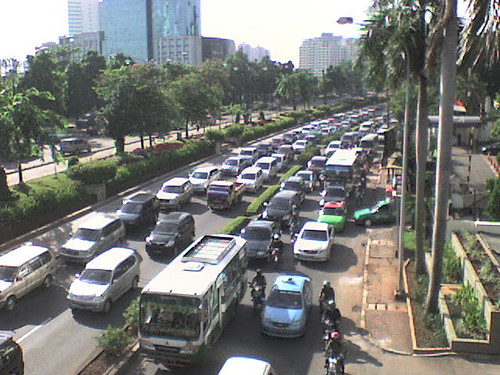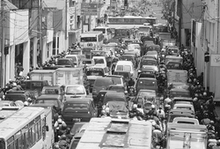Envisioning City without Cars
Traffic congestion is one of the chronic problems in most Indonesian cities and this problem is getting worse year by year. The growth of road developments in Indonesian cities is much slower than the growth rate of vehicle ownership. In Jakarta, for example, the growth rate of vehicle ownership is 9 to 11 percent per year but the growth of road developments is only less than 1 percent per year.

Setiabudi Macet 1, originally uploaded by susiloadhy. When a new highway was built or a road was widened, it will only solve the traffic congestion for a short period of time. After a few years, the new highway will fill with traffic that would not have existed if the highway had not been built. Similarly, the widened road fills with more traffic in a few months. Such phenomenon is called induced demand. Because of the induced demand, neither building new roads nor widening roads are the long-lasting solution to traffic congestion.
There are several possible solutions to eradicate traffic congestion problems and one of them is the reduction of private vehicle uses. I read an article in the New York Times (May 12, 2009) on a suburb town without cars in Germany with great interest. Streets in this upscale town are completely car-free except the main thoroughfare and a few streets on on edge of the town. The residents of this town are still allowed to own cars, but parking is relegated to two large garages at the edge of the development.
The Vauban town, is located on the outskirt of Freiburg, near the French and Swiss borders and home to 5,500 residents. The residents are heavily dependent on the tram to downtown Freiburg and many of them take to car-sharing when longer excursions are needed. Seventy percent of Vauban's families have no cars. They do a lot of walking and biking to shops, banks, restaurants, schools and other destinations that are interspersed among homes. The town is long and relatively narrow and provides an easy walking access to the tram for every home.
Creating places with more compact design, more accessible to public transportation and less driving is the envision of urban planners in the 21st century. The Vauban town is an exemplar of the 21st century urban design in response to the threats of greenhouse gas emission and global warming and the dwindling oil supply.
I could argue that the Vauban's urban design is the extention of the New Urbanism. The New Urbanism is a school of urban design arose in the U.S. in the early 1980s. This school of urban design promotes several key principles including walkability and connectivity, mixed land uses, and high density. There have been many the New Urbanist towns in several countries, but cars still fill the streets of these towns.
The Vauban town provides an example of the possibility of creating city without cars. The walkable and mixed-land-uses urban design, easy access to public transportation and excellent public transportation system as demonstrated in the Vauban town are the components for creating city without cars.
Cars are still a luxury item for many Indonesian families. Many urban residents, particularly those live in kampung kota, do not own cars and are used to living without cars. Streets (gang) in Indonesia's kampung kota are too narrow for cars and the residents are used to walking and biking to their destinations. Kampung kotas are located in the center of urban areas and relatively accessible to public transportations. In reference to the New Urbanism concept, the Indonesia's kampung kota has implemented the principles of walkability and high density.
Indonesian planners need to appreciate the existence of kampung kota in terms of lacking driving needs. Kampung kota residents will be less likely to have a demand for cars when their neighborhoods are accessible to public transportations and the streets in their neighborhoods remain narrow. Kampung kota residents need to remain lack of driving needs for reducing the car ownership rate in urban areas.
For new developments in suburb areas, Indonesian planners can emulate the success of the Vauban town. Driving needs are profoundly affected by the urban design and the high access to public transportation. It makes sense to envision and is not all impossible to create a city without cars.
(This article also appeared at The Jakarta Post on June 2, 2009)




7 comments:
this is good article,but i think to make city without cars particularly when we will apply it in Jakarta for instance, we have to considered about land use and the land use and its pattern. In case of Brasilia, because of strict land use regulations, the population live far away to outskirts and therefore it makes the population in the center became fewer, so that it triggered such population to find other outskirt areas which have cheaper in land price. the transportation infrastructure cost,for every citizen particularly the poor, became higher and the public transportation and other infrastructures can't reach all of citizen there.
in other transportation planning theory, there are 3 components that must be manage inline with transportation planning which are land use regulation, supply side management and demand side management. you only stated supply side which is providing adequate transportation (supply), while the others must be planned in an appropriate way theoretically, thus city without a lot of private cars can be emerge in the next future.
thank you
permana.yudiarso@gmail.com
Hi, Think we can look Japan Country, the people more use bicycle
I stumble on this blog as I was looking for a photograph of traffic in Jakarta. This is a very good post, eventhough to me this is only the begining of a big discussion.
I have a lot of theories on this transportation problem in Jakarta. As a start, this is one of it that could solve the problem: Public Transportation Facilities: There are three types of publict transportation:
1. Taxis to accommodate 1 to 4 people max. at one time,
2. Public Buses could accommodate 50 to 70 people at one time and maybe more at a single trip. By using public bus is already a green behavior as less petrol consumed by a single person.
3. MRT (mass rapid Transit) that could carry thousands of people at one trip.
The later mode is the one that Jakarta do not have unlike any other big cities in the world; even Bangkok and Manila have their LRT that help a lot. What happens to the LRT construction in Jakarta?
I agree that "kampung kota" or urban villages can potentially be a big part of the climate change solution. The way we build, or rebuild, our cities is crucial as more than half the world now live in urban areas and consume much, much more energy for transportation etc than non-urbanites. Ecocity Builders advocates for the Urban Villages model of walkable, mixed-use, centers-oriented neighborhoods served by transit and sufficient green space, trails, and greenways for walking and biking. Great to connect with a fellow Indonesian on urban planning issues.
Good article...i'm agree that high density in urban village will support the mass transport..but i think now the residents in urban village are prefer use an motorcycle than the mass transport..cos using motorcycle is more cheap, efficient, rapid, and dynamics..n for bicycle, it's right that there is a conscious for using bike to work ( for a group of people in using the bike a la mode) but for the poor urban people, using motorcycle is more prestige than using bycycle..what about this ?
Jakarta (& Indonesia) has, and will reamain to have, a problem with status influenced planning.
The middle classes want to emulate the wealthy (who drive cars), and so buy cars. Riding a motor cycle is viewed as a lower class form of transport; as is public transport, and worst of all riding a bicycle or walking.
I cycle in Jakarta, and most locals think I am gila (crazy). Why would a bule (foreigner) cycle or walk when they can afford a car. The concept that a walk can be enjoyable and a pleasant part of a journey does not seem to exist. I understand that the heat and humidity is part of this; also now that the city's poor urban design does not lend itself to many pleasant places to walk (if anyone can think of them, please let me know!)
Planners subscribe to this 'elitist paradigm'. Jakarta is planned for the elites. The poor are forgotten, there is not provision for people that need to walk or cycle to get around. The design of malls is a perfect illustration, where it is easy to be dropped at the front door in a taxi, but difficult to navigate to the mall on foot from the side of the road.
And so Jakarta's planners will continue to plan for the elites - new subdivisions are all car dependant, based on the concept that 'everyone who can afford it MUST own a car'.
This paradigm of thinking is 20 years or so behind urban planning in europe, however that is not really surprising - wealth & the rise of a middle class in Indonesia is a fairly new phenomenon.
To stand any chance of changing this 'mental transport hierarchy' high quality public transport is essential. Clean, air conditioned, frequent, affordable and fast transport is essential if it is to compete with the private car.
Penalties for car use also needs to be implemented, such as a congestion charging zone vis-a-vis London, higher taxation for private car ownership, higher taxation for company cars, development control that reduces the number of car parking spaces associated with new developments.
These 'stick'approaches MUST be enforced. Lack of enforcement of road rules, bus priority, parking, motorcycles riding on the footpaths, etc means that you can have all of the positive initiatives in the world, but if people don't care & are never penalised for doing the wrong things they will never comply.
Jakarta needs the creation of transport oriented developments that 'design out cars'. This will require careful consideration of landscape design - often an 'add-on' to subdivision design. If people are to walk or cycle they need pleasant environments in which to do so, with trees and shade, and streetscapes that maximise airflow and cooling.
The challenges are massive, and only an integrated and politically committed approach over the long term will stand any chance to achieve any change. Up until then Jakarta will continue to stew in its own fetid, polluted air.
transportation is considered as one of our basic needs and that...plays an important role in our daily living
Post a Comment